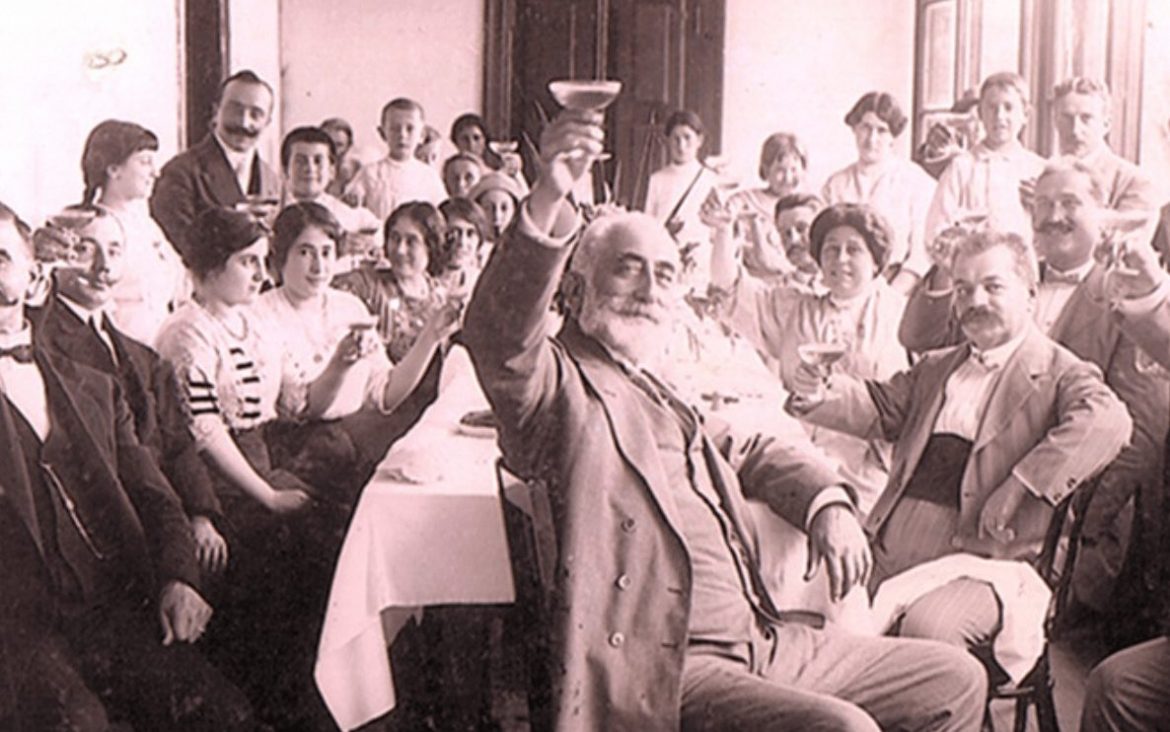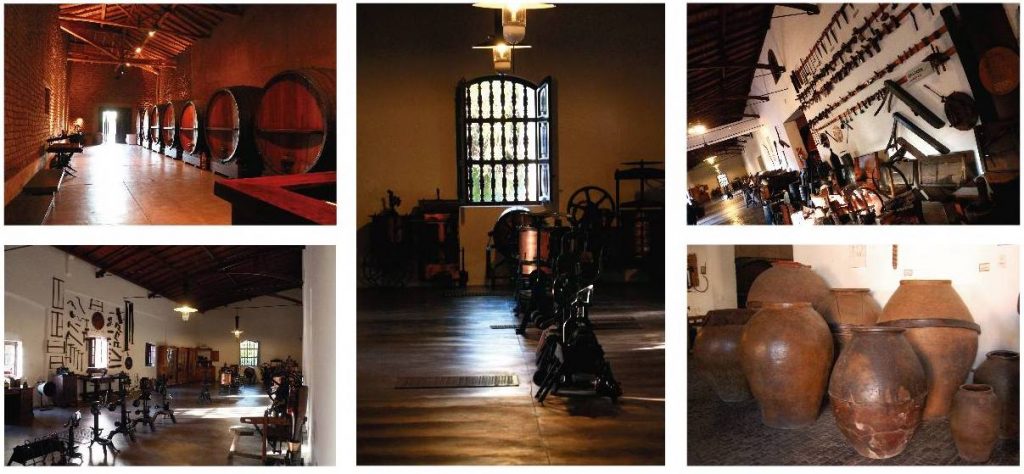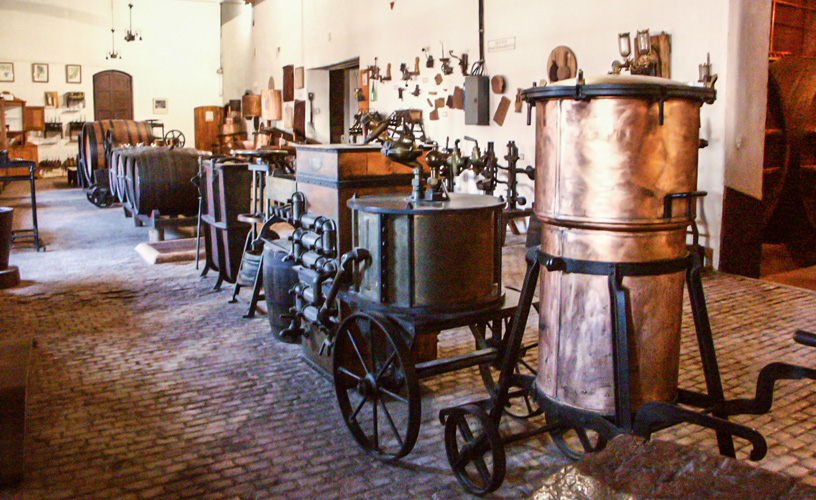Mendoza has a rich history of winemaking which has been heavily influenced by the Italian immigrant community. Clorrie Yeomans interviews Professor Adolfo Omar Cueto is Mendoza’s top historian, lecturing at the National University of Cuyo, about the history of Mendoza and how Italian immigration helped shape the wine industry, as well as the local gastronomy, architecture and art. This interview took place in the historic San Felipe Wine Museum in Bodega La Rural winery.
Argentina is often referred to as the most European country in South America due to the waves of European immigration that it has received. Can you specify the different time periods in which Europeans came to Mendoza, in particular from Italy?

Since the foundation of Mendoza in 1561, until the end of the colonial period in 1810, only Spanish people were allowed to immigrate to Argentina. As a result, very few people from other countries arrived. Nonetheless, a small number of Italians did immigrate to Argentina during this period. They were usually professionals, such as lawyers, architects and engineers, from international companies. A large number of these workers were involved in the mining industry.
During the Civil War period from 1810 and 1861, very few immigrants came to Argentina. From 1861 onwards, Buenos Aires, amongst other provinces, underwent a period of major development under what we call the ‘Liberal governments’. These politicians were aware that in order to govern the country, they needed a bigger population to boost productivity. There were some Italians that worked in agriculture at the time, but not in Mendoza.
An attractive immigration policy was introduced under the local government of Francisco Civit so that foreign workers and companies would fill the labour shortages. During this period, the first few Italians arrived in Mendoza.
So, when was the main wave of Italian immigration in Mendoza?
The arrival of the railway in Mendoza in 1885 triggered an influx of immigrants during the period which we call ‘the great immigration’ in Argentina. This period of mass immigration lasted from 1885 to 1910. In Mendoza, the two main groups of immigrants were Italians and Spaniards. However, people also came over from France, Germany and England. Nonetheless, the immigrants who stood out the most were the Italians because they spoke a different language and had different customs. Whereas, we did not really notice the Spanish immigrants because we speak the same language as them.
Why did so many immigrants come from Italy, rather than other European countries?
On the one hand, Argentinean presidents, including Sarmiento, Avellaneda and Roca, primarily wanted English and Scottish immigrants, rather than immigrants from Latin cultures. The belief that some cultures are superior to others was still very strong at the time. However, Britain needed its workforce during the Industrial Revolution so the government was not going to let people leave.
Italy, on the other hand, was suffering from some really serious social conflicts. In addition, a Malaria epidemic broke out in Rome around 1880. And so the standard of living in Italy was extremely low. For the Italian government, the fewer citizens they had to look after, the better. Consequently, from 1875 to 1975, an astounding 70 million Italians immigrated to other countries!
In fact, the money that Italian immigrants sent back to their families in Italy through the Bank of Italy significantly improved the quality of life of the remaining Italians. Indeed, this economic aid helped to bring about the unification of Italy. So, when we analyse the impact of Italian immigration we must not overlook the benefits which it brought about for Italy, as well as the transformations in the receiving country.
How did these first Italian immigrants earn a living?
Most of the Italian immigrants worked on farms but they did not own the land. However, there were also some Italians winemakers who helped to bring about the viticultural boom in Mendoza. For example, we are in the La Rural winery. This bodega was founded by the Italian Felipe Rutini who arrived in Argentina in 1889 and established the winery in 1895. Many Italians settled in cities, where they set up their own small businesses; for example, they were hairdressers and shoemakers. Indeed, these immigrants started to form what we would call the middle class. This significantly changed the social structure and political system in Argentina and Mendoza.
What was the impact of Italian immigration on the winemaking industry in particular?
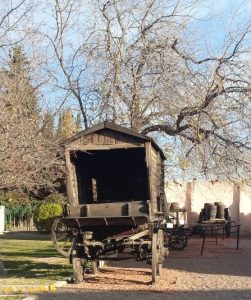
From the end of the 19th century onwards the winemaking industry became the principal industry in Mendoza, since the cereal industry was destroyed after the 1861 earthquake and the mining industry died down. Remember that the Spanish and Italian immigrants were from winemaking regions. Consequently, they manage to easily integrate into society in Mendoza. The immigrants also represented a source of skilled labour in the vineyards and wineries. And, as they were used to drinking wine, demand soared and the domestic market grew considerably.
These European immigrants also brought over a lot of technology which transformed winemaking in Mendoza. Even if they did not manage to bring over the machinery, they knew what they needed to buy in Argentina.
For most Argentineans, the concept of selling their products in European markets seemed impossible. On the other hand, these Italian and European winemakers were familiar with European markets. As a result, they were not just winemakers but rather business people striving to commercialise their products and explore new export markets.
How did Italian immigration help to introduce the variety of different wines which are produced in Argentina?
The Italian immigrants brought over vines from grape varieties which were typical to their particular regions and planted them in Argentina. As a result, the quality and diversity of wines produced in Mendoza significantly increased. Whereas at the time, the Criolla grape varieties produced very limited quality wines.
Why did these immigrants decide to stay and not to return to Italy?
Well, a small number of Italians did manage to achieve the ‘American dream’, as they say. Juan Giol came to Mendoza and established his winery. His business was extremely successful and in 1917, he was able to sell everything. He then lived very comfortably for the rest of his life in Italy.
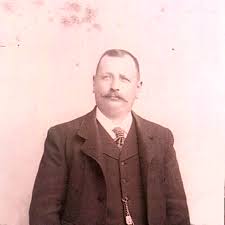
And what happened to Felipe Rutini? As I already mentioned, Rutini established his winery, Bodega La Rural, in 1895. His business was so successful that he was able to send his wife and children to Italy, so that his children could study there. Rutini crossed the Atlantic to visit his family on a regular basis.
Lots of these immigrants who were nobodies in their own countries became respectable members of society here in Mendoza by marrying upper-class Argentinean girls. In general, the immigrant middle class lived very well here. Besides, they had sold everything to come to Argentina, so they had nothing to come back to thirty or forty years later.
So, did the majority of the European immigrants manage to make a better life for themselves in Argentina?
No, in fact, it did not go well for a considerable number of immigrants. However, they did not have the money to pay for a return ticket to Europe. Going back to Europe with nothing was just as bad as staying in Argentina.
During the end of the 19th century or the beginning of the 20th century, the social structure in continental Europe was still pretty much the same as that of Medieval times.
How did the first significant wave of Italian immigration change the physical characteristics of the ‘typical Mendocinian’?
This huge influx of immigration transformed phenotype of the creole. Especially in the ‘central belt’ of Argentina; which is the most populated part of the country stretching from Buenos Aires over to Cordoba and Mendoza.
How did the communities of Italian immigrants influence the local culture in Mendoza?
In 1881, these Italian immigrants had already started to form cultural societies. These groups organised activities and events in order to conserve the Italian culture, customs and language. They also set up Italian schools for children and during the weekend, they would meet up and eat together like old times in their villages.
Do these cultural societies still exist in Mendoza?
The Italian Hospital and the Dante Alighieri School, both of which still exist today in Mendoza, were built in part thanks to the influence of these Italian immigrant societies. These associations do not just exist for the Italians. The French Alliance, for example, has a very similar structure. These organisations primarily aimed to form and maintain connections between the immigrants and their home countries.
If so many Italians came to Argentina, then why is Italian not a second language here?
What happened is the Italian immigrants had to learn to speak Spanish to communicate with the majority of the population. What’s more, for some immigrant families who mainly spoke their dialects, standard Italian was their second language so they stopped speaking it. Then English and French started to be taught as part of the national curriculum which meant that Italian disappeared. Other than the bilingual Dante Alighiera school, very few institutions teach Italian now. In fact, we have stopped recruiting Italian teachers in the Faculty of Arts at the Cuyo National University due to a lack of demand.
That’s a shame. Are Argentineans reluctant to learn foreign languages then?
No, I would not say that Argentineans are reluctant to learn languages. They have less opportunities to practise their languages. You have to remember that in Europe, lots of students have the chance to participate in language exchanges and the Erasmus programme. In South America, the same language is spoken in all of the countries except Brazil. This means that we have to travel 14,000 kilometres to Europe in order to get some practice. Many people don’t have the money to travel to Europe and they therefore forget what they learnt at school.
The same thing happened to the descendants of the Italian immigrants. Gradually, they lost the language which their grandparents spoke as they assimilated with the rest of the population. On the other hand, if the Italians had all moved to the same places and formed closed communities, then perhaps we would still speak Italian in some parts of Argentina*.
{Editor’s Note: This is why Welsh is still spoken, often as a first language, in Gaiman, Trelew and Trevelin in Patagonia.}
How did Italian immigration impact the gastronomy and culinary culture in Mendoza?
Pasta is a popular dish in Mendoza. However, before the waves of Italian immigration, pasta did not exist here. The Italian immigrants brought pasta over from Europe to Argentina. One day, they decided to start making it in Argentina. Then, the local people started to enjoy these Italian dishes, too. As the Spanish and Italian immigrants came from different regions, they brought their own regional food, customs and culture with them. As a result, Argentina is a melting pot of cultures.
Argentineans speak a very different variety of Spanish to what you will hear in Spain. How did Italian immigration impact the language here?
In South America, there are infinite different varieties of Spanish. An Argentinean would sometimes struggle to understand a Chilean, for example, as we have so many words that are different. When the Italian immigrants arrived in Buenos Aires, they spoke a broken Spanish mixed with Italian which was called ‘lunfardo’. Indeed, the lyrics of Tango music are heavily inspired by lunfardo.
Very interesting. So, the roots of Argentinean culture aren’t just Spanish…
In Mendoza, you will see that there is a huge Italian influence in terms of the architecture. The Italian winemakers who arrived in Argentina in 1900 built their wineries with an Italian style of architecture. Some of the oldest buildings in Mendoza are influenced by Italian architecture. These buildings still stand today and are a reminder of the lasting presence of Italian culture in Mendoza.
So, tell us a little bit about the San Felipe Wine Museum where we are here in the Bodega La Rural.
Winemaker Felipe Rutini’s grandson, Doctor Rodolfo Reina Rutini, worked for years to bring together a collection of winemaking artefacts and establish the San Felipe Wine Museum in the Bodega La Rural winery. The museum now houses a collection of over 6,000 items which show the progression of winemaking in Argentina from the colonial period to the present day. Don’t forget to go inside the ‘Immigrant’s House’ which is full of memorabilia from the Rutini family including photos and the original plans of the winery drawn by Felipe Rutini.
What is unique about this museum is that it is located within the old winery which still continues to produce wine today (although the majority of production is based in an external winery). Tourists who come during the harvest season see the trucks pulling up outside the winery full of grapes!
We have placed some of the artefacts next to the modern machinery that we use to make wine today so that people can see how much winemaking has advanced. Not only do we have artefacts from the Bodega La Rural, but we also have many items which tell the story of winemaking in Argentina in general.
Yes, definitely! Thank you, Professor Cueto, for sharing the fascinating history of Italian immigration in Mendoza and Argentina with us!
Interview by Clorrie Yeomans
Find out more about the Bodega La Rural winery in our Argentina winery guide.
Read more about the history of Mendoza
-
Argentino de la Mota, Raúl (2001), ‘Una breve historia del vino argentino’, Bodegas y Terruños, 9: January 2001.
-
Barrio, Patricia (2010), Hacer vino: Empresarios vitivinícolas y Estado en Mendoza (1900-1912), Rosario: Prohistoria Ediciones.
-
Catena, Laura (2010), Vino Argentino: An Insider’s Guide to the Wines and Wine Country of Argentina, San Francisco, Calif.: Chronicle Books.
-
Collado, Patricia A. (2006), ‘Desarrollo vitivinícola en Mendoza – Argentina. Apuntes sobre su origen‘, Trabajo y Sociedad: Indagaciones sobre el empleo, la cultura y las prácticas políticas en sociedades segmentadas, 8:7.
-
Correas, Jaime (1992), Historias de familias, Mendoza: Primera Fila.
- Lacoste, Pablo (2003), El vino del inmigrante: los inmigrantes europeos y la industria vitivinícola argentina: su incidencia en la incorporación, difusión y estandarización del uso de topónimos europeos 1852-1980, 1st ed., Mendoza: Consejo Empresario Mendocino.
- Mateu, Ana María (2008), ‘La vitivinicultura mendocina entre 1870 y 1920: La génesis de un modelo centenario’ in María Mateu, Ana & Stein, Steve (eds), El vino y sus revoluciones: Una antología histórica sobre el desarrollo de la industria vitivinícola argentina, Mendoza: EDIUNC Editorial de la Universidad Nacional de Cuyo.
- Richard-Jorba, Rodolfo (2004), ‘¿Echar raíces o hacer la America? Un panorama de la inmigración europea hacia la región vitivinícola argentina y algunos itinerarios económicos en la provincia de Mendoza, 1850-1914′, Amérique Latine: Histoire & Mémoire, 9: 2004: Migrations en Argentine II.
- Richard-Jorba, Rodolfo (2008), ‘Sumando esfuerzos y conocimientos. La inmigración europea en el desarrollo de la viticultura capitalista en la provincia de Mendoza: Incorporación y difusión de técnicas agrícolas modernas, 1870-1910‘, Centro de Estudios Históricos ‘Profesor Carlos A. Segreti’.
